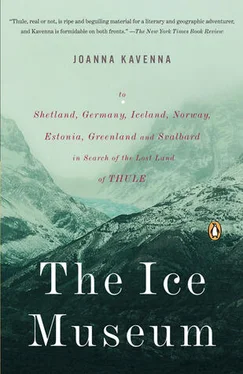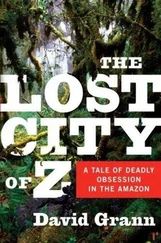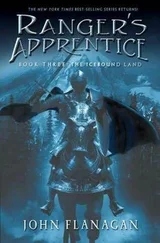I jostled determinedly with a few local drunks for possession of a bench by the harbour, under a statue of Amundsen in oilskins, facing the ocean. Amundsen had flown out from Tromsø, to go to the rescue of a former friend, a former colleague on his flight above the North Pole. There were rumours that Nobile had infuriated Amundsen on the flight. Nobile had told Amundsen that the airship could only hold a single national flag from each party, a small pennant, nothing heavier. Amundsen had obliged, packing a small flag, the sort of flag a child might hold on a special occasion. Above the Pole, Amundsen had thrown the small pennant from the airship, watching it flutter towards the ice. Nobile had produced a vast box, containing an enormous Italian flag, and hurled its vastness onto the ice, trumping Amundsen’s efforts entirely. It was a comic story Amundsen told, possibly apocryphal. It was hardly enough to prevent him from flying out to save Nobile. He balanced all, brought all to mind, and disappeared in a small plane, into the mist. The people of Tromsø had commemorated him with a solitary statue, now stranded on a traffic island, staring indignantly at the coast, trying not to look into the windows of the Comfort Hotel directly behind him. The statue was weatherworn and faded, but it was a clear rendering of the man, his unmistakable profile, his staggering nose, a nose like a challenge. I sat on the bench beneath him, looking up at his silhouette. There were rows of NATO soldiers walking along the quayside, waiting for a lift further north. The pale sun warmed the wind, which gusted through the streets, through the main street, which was dotted with wooden houses and dull concrete high-rise hotels. I passed along the quayside and crossed a scenic stretch of the harbour, past low wooden sail lofts, and a collection of antiquated fishing boats, a mass of polished planks and intricate rigging.
There was another Amundsen in Tromsø, a bust rather than a statue, staring out across another patch of water from the car park of the Polar Museum. The Polar Museum was full of compelling Arctic junk, all the rusting teaspoons and polished ski-runners and blurred photographs of explorers standing by boats and aeroplanes, preparing to launch themselves northwards. Row upon row of blurred portraits of nineteenth-century fur trappers, standing sombrely in front of a grotesque array of seal pelts. Away from the skis and sledges and navigation equipment, I stopped at a glass cabinet, containing a pocket-sized, brown leather copy of Frithjof’s Saga , a tale of chivalric courage and frostbitten love, adapted from an Icelandic Saga by Esaias Tegnér. The book was opened at the frontispiece, which had an inscription in it, written by Amundsen, dated 1926: ‘This book came with me on all my expeditions, Roald Amundsen.’ Nansen, a Frithjof by name, could recite long passages by heart.
Nansen was there in the museum, among the skis and sledges and navigation equipment, in the newspaper clippings, celebrating his farthest north, celebrating the return of Fram to Norway, full of civic excitement. There were dour photographs of Nansen’s later life in the museum, when he stared mournfully at the camera, and there was a large shabby waxwork, a puppet rendering of the man. This Nansen mannequin had a comically huge moustache, ruddy features, and an emaciated frame. The waxwork was falling apart; on one hand the fingers were sellotaped to the wrist. It was a bizarre tribute to the explorer, surveying the room with large blue eyes, staring at the torn newspaper cuttings and the maps of the north.
The sun slid slowly across the sky, its colours reflected in the clear waters of the fjord. Everything was very quiet in Tromsø, even as the bars began to fill. The cars moved slowly along the cobbled streets. On Storgata, the main street, the shops were beginning to close, shutters drawn against the long Arctic evening.
After a hundred more rocks, sullen in the cold afternoon, we had turned east and were heading towards the Russian coast. The ship was passing along the scrawny last rags of Norway, a country that shrinks from the swollen girth of its southern regions to the emaciation of the north. The mountains had lost their trees, and the towns were hard and functional. Hammerfest slipped past at 3 A.M., a place calling itself the world’s most northerly town, its lights shimmering on the waves. Cold on the deck, huddled in a sleeping bag because I had fallen asleep while watching the sunset, I woke to the sound of the ship docking, and fell asleep again before we had left the harbour.
When I woke again in the rich dawn, the ship was sliding towards another old rock, this one with significance daubed upon it by earlier travellers. The atmosphere on deck was expectant. We were approaching North Cape, formerly the last point of Europe. I arrived in a strange mood. North Cape was a tourist magnet, a formerly significant goal, once a place embedded among thousands of miles of hostile nature, now easy enough for the tourists to find, as they reclined in the buses, clicking cameras at the rocks and tundra. North Cape was a significant rock, named by Richard Chancellor, a sixteenth-century English captain, who sailed past the lump of rock on the way to the White Sea. Chancellor landed at Archangel and set out for Moscow, where he and his crew were received at the court of Ivan the Terrible. Chancellor returned triumphantly to England, preparing to make a fortune in fur trading, the fashionable commodity from the north, but he was lost at sea the next year, on another profit-making expedition. North Cape stayed in the minds of sailors and explorers; the horn pointing out to sea was a landmark visible from the ocean as the boats sailed along the storm coasts.
I drifted through the glass-fronted building, built like a hi-tech physics department, called the North Cape Centre, a tourist hypermarket at the formerly most mysterious place. The Norwegian attendants suggested I might like to buy some North Cape merchandise, and nudged me towards a supermarket full of North Cape tankards, North Cape cuddly toys, North Cape postcards, North Cape pennants. A first wave of tourists moved into the supermarket, towards the videos of circling seabirds, through the aisles of trinkets, but I moved slowly onwards, down a corridor. Pushed along in a grand flow of tourists, I walked through an exhibition in glass cases, with plastic figures posed into tableaux, representing past visitors. There was a plastic figurine of the Italian explorer Francesco Negri, who emerged onto the rocks in 1664 and wrote: ‘I am now at North Cape, on the exterior coast of Finnmark and at the roof of the world . . . My curiosity is now satisfied, and I wish to return to Denmark, and if God is willing, to my own country. ’ There was a description of the arrival of Louis-Philippe d’Orléans, who came in 1795, in exile from France. He visited Oslo, Trondheim and Bodø, and continued to North Cape. North Cape was the sort of destination that might attract a man like Louis-Philippe, who later travelled on horseback around America. There was a portrait of the rocks, showing Louis-Philippe and his party on the shores below North Cape, preparing to clamber up the cliff. It was sentimental—the prince and his cohorts were standing above a swollen ocean, staring reverently at the great rock, while sailors struggled to lash the sail to the mast. In the background stood the great grey escarpment, blanched by a pale sky. All this idealism, this passionate excitement, splashed across the rocks; centuries of overwhelmed travellers, arriving at an escarpment which an otherwise forgotten sailor had called North Cape, and sinking to their knees: princes, explorers, sailors, traders. A great line of satisfied people; in the nineteenth century they came reciting lines from Henry Wadsworth Longfellow: the ‘huge and haggard shape/ of that unknown North Cape/ Whose form is like a wedge.’ They all came, they unloaded their quotations, like a picnic rug and plates, they relaxed into the created significance of the rocks, and then they packed everything up and went home.
Читать дальше












